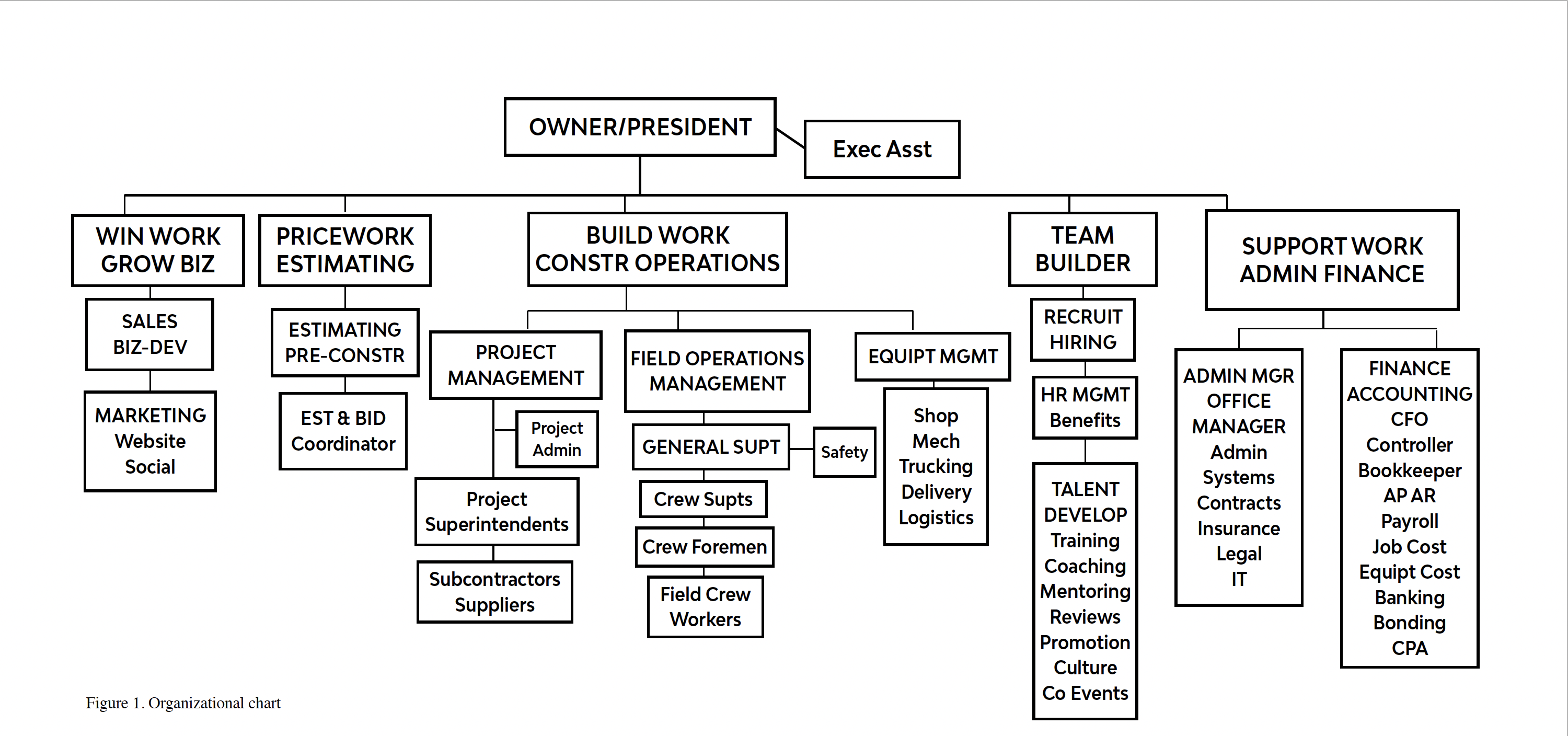
Many contractors want to grow their companies to the next level but can’t and therefore don’t. They usually get stuck at a certain size and stop growing for multiple reasons. Working harder and smarter doesn’t solve this problem, and eventually they reach their maximum level of what they can do without hiring more people. Why? Business owners try to do too much themselves and have trouble letting go and allowing their employees to make their own decisions. They know they need to hire but won’t decide what positions they need to fill, what they need to stop doing themselves and who to hire. They postpone hiring decisions as they don’t want to deal with the pain of interviewing, hiring, training, paying more than they want for experience and talent, and then the probability of not getting what they had hoped for.
What’s Your Primary Role & Focus?
It’s important that business owners determine what their primary role should be based on what the company needs, what roles they are the best at, what they should handle, and what they want or like to do. Most construction business owners are best at developing and implementing strategy, providing leadership, reviewing estimates, winning work and developing customer relationships. But when they act as project managers, estimators or field general supervisors, they’re generally not doing what they do best. Therefore, their focus and priorities are on the wrong things and hold back their company from growth.
For example, when companies don’t have enough of the right people in place to handle the workload, the owner or president steps in and does what’s required to compete projects versus doing what they should be doing including calling on customers or watching the finances. When the owner manages or estimates projects, he or she is not minding the store, spending time to mentor and coach the team, reviewing direct reports, or finding time to attract, hire, mentor, develop and retain talent.
Don’t Hire Cheap & Hope It Works Out
Frustrated, stuck business owners finally hire an experienced manager with a strong resume so they can delegate part of their workload. Unfortunately, their first instinct is to move someone from within the company who has little or no experience or skills in the area they need the most. Examples include moving an office administrator into the bookkeeper role or a junior assistant into a project manager role. After trying to move an inexperienced person, they next hire a low-paid assistant, untrained field supervisor, junior project manager or an estimator with little experience or knowledge for the position they need. Or even worse: Rather than take the time required to find the right person with the right talent and experience, they attempt to hire a relative or family friend who is out of work and might be able to do the job.
These decisions won’t help companies move to the next level. You know what happens when you hire untrained people with little or no management experience? You spend all your time trying to keep them busy, answering their questions, helping them do simple tasks and training them. In other words, you do your job plus theirs.
Evaluate Your Talent Needs With T-E-V
There are three important T-E-V criteria you can use to evaluate your current team and potential hires.
- T = Talent — Do they have the right talent, education and intelligence to do the job well, improve, make decisions and take on more responsibility?
- E = Experience — Do they have the right experience and knowledge required to manage complex projects, provide solutions, organize, meet deadlines, achieve results and manage subcontractors, suppliers and customer situations in a professional manner?
- V = Values — Do they have the right values required by the company, including a positive attitude, teamwork, integrity, honesty, willingness to change, desire to improve, and the ability to make decisions and achieve expected results?
Consider the different criteria to determine if people are a good fit for your company:
- High T + High E + High V = Great employee who is or can be a strong asset to your team.
- High T + Low E + High V = Has the right criteria to hire, train, promote, develop and invest time in.
- Anyone with Low V = Avoid or eliminate! Not someone you ever want to have on your team. Ever!
- Anyone with Low T = This person might be able to learn how to perform well but is a large risk.
Hire or Delegate?
A busy construction company owner or president usually has too many activities they’re responsible for. So where should owners spend their time, and what roles or positions should they hire or delegate? The roles to consider are sales, estimating, project management, field supervision or financial management. To decide your best and most effective role, rank what will give your company the highest return for growth and profitability. Successful company presidents primarily focus on providing effective visionary innovative leadership, winning high-margin sales, customer development, overseeing the estimating department, growing capacity, and hiring and developing top talent. To make your vision become a reality, you must make tough decisions to:
- Stop doing the work including acting as a project manager, estimator, and general field supervisor.
- Focus on growing your company and building capacity by hiring the right people with the right talent, the right experience and the right values with the ability to move into a more responsible leadership position.
- Delegate and let go of making too many decisions for your team.
- Decide to hire a winning team, including a T-E-V full charge experienced bookkeeper; T-E-V executive assistant, office manager, project administrator or estimating coordinator; and T-E-V professional project manager or field manager/supervisor.
- Upgrade and implement fully integrated software for accounting and job cost, estimating, project management, field management and scheduling.

Design Your Construction Company Organizational Chart
The goals of a written and clear organizational chart are to provide clarity on the following:
- Functions and responsibilities.
- Line of command — clearly defines who reports to who.
- Workflow — The flow of work and activities from one person to the next, or from project start to finish.
- Person 100% accountable for accomplishing all tasks and deadlines required per the company standards, systems and processes.
Each box needs a clear job description listing the responsibilities, tasks and results required to achieve, with deadlines, plus the person assigned. With smaller companies, some employees might have their names in more than one function box. For example, a project manager might also oversee his field supervisors and foremen, or an office manager might also perform the project administrator and estimating coordinator duties.
Most organizational charts are only used to show who reports to whom and not who’s accountable for getting the work done. They also don’t lay out all tasks and functions required to make your company achieve its strategic goals. The best way to organize your company and draft your organizational chart is to take out a large piece of chart paper and lay out all the tasks and jobs that must be accomplished, from finding work to doing work, keeping track, administration and managing your workflow. Write on one sticky note for each function required in your business to accomplish what your company does. After completing this exercise, post these tasks beneath the function headings in logical order of how you get things done.
For example, under the “Do Work” heading would be the project management responsibility. A full-charge project manager responsibilities include procurement, negotiating subcontracts and purchase orders, writing contracts, project documentation, correspondence, customer meetings, change order management, preparing and updating job budgets, approving and updating job schedules, drafting progress payments, approving invoices, meeting contract requirements, making the job profit goal, meeting the project schedule, customer satisfaction and other responsibilities. Make sure you clearly define each position’s level of financial authority, their line of command and who they report directly to.
Who’s Responsible for Getting Things Done?
After your chart is completed, the next step is to assign people who are accountable for each of the work tasks listed. This is tricky. If the construction business owner allows a project manager to draft the subcontracts but not make the final decision on the price or the selection of subcontractors without checking in first, then this task needs to be broken down into two or three parts: draft contract, approve subcontractor and negotiate final contract amount. That way you can enter the two names responsible and accountable for these different tasks and responsibilities. Now, create an accountability and responsibility chart listing out all the functions in your company. Assign the appropriate person who is the responsible person for each task and business function.

